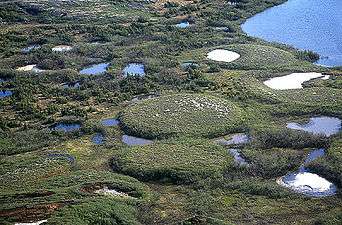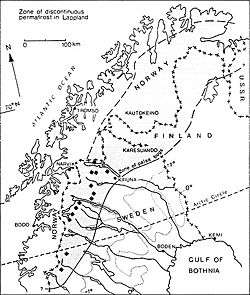Palsa

Palsas are low, often oval, frost heaves occurring in polar and subpolar climates, which contain permanently frozen ice lenses. Like pingos, palsas consist of an ice core with overlying soil, but they are generally smaller than pingos, often occur in groups and may develop from ground water without additional hydrostatic pressure. Palsas are characteristically found in areas with discontinuous permafrost, and in such areas they may be the only reliable surface evidence of permafrost. Palsas need large quantities of water for the formation of their ice lenses, and for this reason they occur particularly in bogs.
Genesis
Palsas may be initiated in areas of a moor or bog where the winter freezing front penetrates relatively faster than surrounding areas, perhaps due to an unusually thin cover of snow. The lack of thermal insulation provided by thick snow permits much deeper freezing in winter. This ice may then last through the summer with a persistent 'bump' of up to several cm due to frost heave. The elevated surface of a palsa will tend also to have thinner snow cover, allowing greater winter cooling, while in summer the surface material (especially if organic) will dry out and provide thermal insulation. Thus the interior temperature is consistently lower than that of adjacent ground. This contributes to the formation of an ice lens which grows by drawing up surrounding water. The expansion of the ice upon freezing exerts pressure on the surrounding soil, further forcing water out of its pore spaces which then accumulates on and increases the volume of the growing ice lens. A positive feedback loop develops. Changes in surface moisture and vegetation will then be such as to preserve the newly formed permafrost.
The overlying soil layer is gradually lifted up by frost heaving.[1] In cross-section, the ice cores of a palsa show layering, which is caused by the successive winter freezing intervals. The pressing out of water from the pores is not crucial, however, since the boggy soil is water-saturated and thus always provides enough water for ice core growth.
Palsas appear to go through a developmental cycle that eventually leads to thawing and collapse. Open cracks that commonly accompany palsa growth and the water that tends to accumulate around palsas, probably as a result of their weight depressing the adjacent bog surface, are important factors in this process. The fact that palsas in various stages of growth and decay occur together shows that their collapse is not necessarily indicative of climatic change. All that is usually left after a palsa collapses is a depression surrounded by a rim.
Morphology
Palsa forms include mounds, moderately straight ridges, and winding ridges. Palsas in Iceland have been described as hump shaped, dike shaped, plateau shaped, ring shaped, and shield shaped, those in Norway as palsa plateaus, esker palsas, string palsas, conical ore dome-shaped palsas, and palsa complexes.
Widths are commonly 10–30 m, and lengths 15–150 m. However, lengths of up to 500 m have been reported for esker-like palsa ridges running parallel to the gradient of a bog. Heights range from less than 1 m to about 10 m at a maximum above the surrounding area. Large forms tend to be considerably less conical than small ones. In places, palsas combine to form complexes several hundred meters in extent. The permafrost core contains ice lenses no thicker than 2–3 cm, though locally lenses up to almost 40 cm thick have been described.
Palsas form in groups or "fields" and the individual palsa can show its age difference from the others.
Palsa surfaces are frequently traversed by open cracks, caused by doming (dilation cracking), frost cracking, or desiccation. The vegetation of a palsa may comprise low shrubs and lichen in addition to the sedges characterizing the peat. Also, the higher a palsa grows the dryer the peat covering the palsa becomes leading to more insulation which protects the inner core from melting.
There are two types of palsas, those with a peat core and those with a core of mineral soil, usually silt. The peat-core type is the most common, the other being regarded as exceptional by some, but more common than formerly thought.
Permafrost plateau
Permafrost plateaus are structures of coalesced palsas that form a continuous elevated flatland area usually in a peat bog. Permafrost plateaus may have parts suffering decay while others are growing at the same time. Permafrost plateaus are usually surrounded by wetlands but have often internal water pools during summer due to uneven relief, partial decay and thaw.
Geographic distribution

Palsas are typical forms of the discontinuous permafrost zone regions and are therefore found in Subarctic regions of northern Canada and Alaska, Siberia, northern Fennoscandia and Iceland.[2] They are almost exclusively associated with bogs and commonly occur in areas where the winters are long and the snow cover tends to be thin. In some places palsas extend into underlying permafrost; in others they rest on an unfrozen substratum.
In the southern hemisphere palsa remains from the last glacial maximum have been identified on the Argentine side of Isla Grande de Tierra del Fuego just north of Cami Lake.[3] Remainders of Ice-Age palsas are to be found also in Hochmooren of Central Europe, such as Hohen Venn in the German-Belgian border area.
Differences and commonalities between pingos and palsas
Palsas are structurally similar to pingos, however with heights between approx. 0.5 and 2 m and lengths between approx. 5 and 25 m, palsas are significantly smaller than pingos. Both however are considered to be true perennial permafrost mounds since both occur in areas of continuous permafrost. Moreover, contrary to pingos which are usually isolated, palsas usually arise in groups with other palsas, such as in a so-called palsamoor. Unlike pingos, palsas do not require surrounding permafrost to grow, seeing as palsa are permafrost. Pingos also grow below the active layer, which is the depth that the annual freeze-thaw cycle occurs, and palsa grow in the active layer.
Both palsas and pingos result from freezing of water to an ice core. Palsas, however, do not necessarily require positive hydrostatic pressure (to inject water), since the boggy soil is water-saturated and therefore has sufficient supply for the growing ice core.
Terminology and synonyms
Palsa (plural: palsas) is a term from the Finnish language meaning "a hummock rising out of a bog with a core of ice," which in turn is a borrowing from Northern Sami, balsa.[4] As palsas particularly develop in moorlands they are therefore also named palsamoors. Bugor and bulginniakhs are general terms in the Russian language (the latter of Yakutian origin) for both palsas and pingos.
See also
- Cryoturbation
- Frost heaving
- Gelifluction
- Gelisol
- Ice wedge
- Patterned ground
- Paraglacial
- Periglacial
- Permafrost
- Pingo
- Solifluction
References
- ↑ De Schutter, Paul (2005-12-03), Palsas & Lithalsas, retrieved 2013-06-10
- ↑ Seppälä, Matti (1986), "Origin of palsas", Geografiska Annaler, 68A: 141–147
- ↑ The Late Cenozoic of Patagonia and Tierra del Fuego, retrieved 17 June 2009
- ↑ dictionary.com definition of palsa
Further reading
- Brown, R.J.W.; Kupsch W.O. (1974). Permafrost terminology. Altona, Manitoba: National Research Council Canada.
- Washburn, A.L. (1980). Geocryology. New York: John Wiley & Sons. ISBN 0-470-26582-5.
- Williams, Peter J.; Michael W. Smith (1989). The frozen Earth. New York: Cambridge University Press. ISBN 0-521-36534-1.
External links
Pictures of palsas and further information:
- Palsa, a Fennoscandian term for a round or elongated hillock or mound, maximum height of about 10 m, composed of a peat layer overlying mineral soil.
- William W. Shilts Geologic Image Gallery (Illinois State Geological Survey)
- Field trip guide on periglacial (cryogenic) geomorphology (html)
- Field trip guide on periglacial (cryogenic) geomorphology (pdf)
- Interpretation guide of natural geographic features: Palsa bog (index)
- Interpretation guide of natural geographic features: Palsa bog (aerial photographs)
- €U(RO)CK article from a 2005 issue